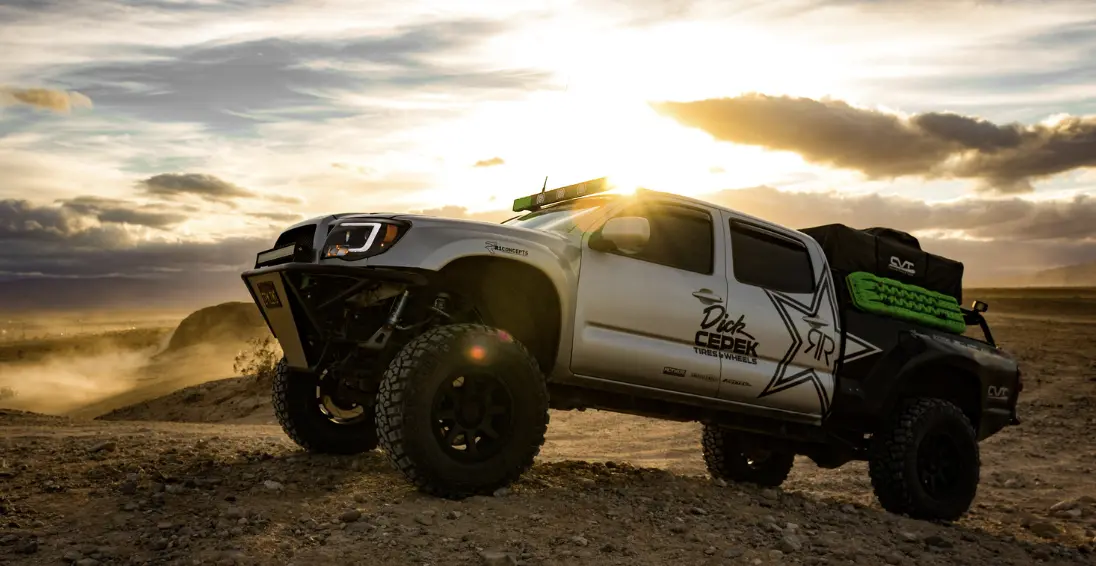In a way, going off road is like getting back to our roots as humans. On foot or on horseback, humans were cutting our way overland without the help of roads for millennia before the first roads were paved. With that in mind, it makes sense that shortly after the first automobiles were invented, humans wanted a way to take these vehicles off the road and across variable terrain. Being able to drive off road is technically possible in just about any kind of vehicle (depending on the terrain) but in order to have the best chance of pushing forward, new technological innovations were necessary. Enter four wheel drive (4WD, or 4×4). The ability to have the engine turn all four wheels at once increases a vehicle’s capacity to negotiate more unforgiving routes. First invented for military applications, this technology has been a crucial part of the automotive world ever since its first use, and it’s still put to use every day for purposes both recreational and utilitarian. Come with us on an off road adventure as we explore how 4×4 came to be, how it works, and how this simple mechanical technology has changed over the years.
A Brief History of 4×4
The concept of four-wheel drive (4WD) for automobiles has its roots in the early 20th century, and it was primarily developed for military and off-road applications where enhanced traction and mobility were required.
One of the earliest known examples of a four-wheel-drive vehicle is the “Spyker 60 HP,” which was designed by Dutch brothers Jacobus and Hendrik-Jan Spijker in 1903. This vehicle featured a revolutionary drive system that delivered power to all four wheels, a significant advancement in automotive technology at the time. The Spyker 60 HP was not only a technical marvel but also a luxury car, showcasing the potential of four-wheel drive for both performance and practicality.
The development of four-wheel drive gained momentum during World War I, when the need for vehicles capable of navigating challenging terrains became evident. One notable example is the Jeffery Quad, produced by the Thomas B. Jeffery Company in the United States. Introduced in 1913, the Jeffery Quad was initially designed for commercial use, but its robust four-wheel-drive system quickly proved valuable for military purposes, leading to its widespread use during the war.

The real proliferation of four-wheel-drive technology, however, occurred during World War II. The Willys MB, commonly known as the Jeep, is perhaps the most iconic four-wheel-drive vehicle from this era. Developed in the early 1940s, the Jeep was designed to meet the U.S. Army’s specifications for a lightweight, all-terrain reconnaissance vehicle. Its success on the battlefield demonstrated the effectiveness of four-wheel drive in rugged conditions and cemented its place in automotive history.
Following the war, the practical benefits of four-wheel drive for civilian use became more apparent, leading to its adoption in a variety of vehicles, including trucks, SUVs, and even passenger cars. Today, four-wheel-drive systems are widely used in the automotive industry, offering improved traction and stability in a range of driving conditions.
4WD, 2WD, and AWD
From a mechanical standpoint, four-wheel drive (4WD), two-wheel drive (2WD), and all-wheel drive (AWD) systems differ in how they distribute power to the vehicle’s wheels.

In a 2WD system, power is delivered to either the front wheels (front-wheel drive) or the rear wheels (rear-wheel drive). This means that only two wheels are responsible for propelling the vehicle forward. This setup is simpler and lighter, which can improve fuel efficiency, but it may not provide as much traction in off-road or slippery conditions as 4WD or AWD systems.
A 4WD system, on the other hand, can deliver power to all four wheels simultaneously. This provides better traction and control, especially in off-road or low-traction environments. Traditionally, 4WD systems are manually engaged by the driver, often using a lever or switch, and are typically used in vehicles designed for off-road or heavy-duty use. Some 4WD systems also offer low-range gearing for extreme off-road conditions.
AWD systems are similar to 4WD in that they can send power to all four wheels, but they differ in their operation. AWD systems are typically always active and automatically adjust the power distribution between the front and rear wheels based on driving conditions. This provides improved traction and handling in a variety of situations, from dry pavement to snowy roads. AWD systems are often found in passenger cars, crossovers, and SUVs where the emphasis is on on-road performance and all-weather capability, rather than heavy-duty off-road use.

In summary, the main mechanical difference between these systems lies in how they distribute power to the wheels and how they are engaged or controlled by the driver or the vehicle’s systems.
Most cars are produced with 2WD because it is simpler, more cost-effective, and more fuel-efficient than 4WD. A 2WD system is less complex and lighter, which means it requires fewer parts, less maintenance, and is cheaper to manufacture. This simplicity also contributes to better fuel efficiency, as there are fewer drivetrain components to add weight and mechanical resistance.
However, 4WD systems face specific challenges and disadvantages that prevent their universal adoption. The added complexity of 4WD systems, with components like transfer cases and additional differentials, leads to higher production costs and potential maintenance issues. The extra weight of these components negatively impacts fuel efficiency and can also affect the vehicle’s performance. Additionally, 4WD vehicles are generally more expensive to purchase due to the higher manufacturing costs. While 4WD offers improved traction and off-road capabilities, it can sometimes result in less desirable handling characteristics on regular roads, such as increased tire wear and a less smooth ride.

For these reasons, 4WD is typically reserved for vehicles where the benefits in traction and off-road performance outweigh the disadvantages, such as SUVs, trucks, and off-road vehicles. In contrast, 2WD remains the more practical choice for many everyday cars and drivers due to its advantages in cost, fuel efficiency, and on-road performance.
How 4×4 Tech Has Changed
The development of four-wheel drive (4WD) technology has seen significant changes and innovations over time, evolving from basic systems designed for rugged terrain to sophisticated setups that enhance performance and safety in a variety of vehicles.
Early 4WD systems were mechanical and manually operated, primarily used in military vehicles and off-road applications. One of the first civilian vehicles to feature 4WD was the Jeep, developed during World War II, which became a symbol of rugged off-road capability and paved the way for future 4WD vehicles.
Over time, technological advancements led to the introduction of full-time 4WD systems, which allowed for continuous power distribution to all four wheels, improving traction and handling. These systems were further enhanced with the development of electronic controls and sensors, enabling more precise and automatic distribution of power based on driving conditions.
One of the major milestones in 4WD technology was the introduction of all-wheel drive (AWD) systems, which are a more sophisticated form of 4WD. AWD systems can automatically adjust the power distribution between the front and rear axles in real-time, providing better traction and stability on various surfaces without manual intervention from the driver.

Vehicles like the Audi Quattro, introduced in the 1980s, were influential in demonstrating the performance advantages of AWD in both racing and consumer vehicles. The Quattro’s success in rallying highlighted the potential of AWD systems to enhance not only off-road capability but also on-road performance and safety.
In recent years, advancements in electronic controls, computer algorithms, and integration with other vehicle systems like stability control and anti-lock brakes have further refined 4WD and AWD technology. This has led to the development of more intelligent and adaptive systems that can predict and react to driving conditions, providing optimal traction and performance.
Looking to the future, 4WD technology is likely to see further integration with electric and hybrid drivetrains, leading to more efficient and environmentally friendly vehicles. Advances in artificial intelligence and machine learning could result in even more sophisticated and autonomous control of 4WD systems, enhancing safety and performance in challenging driving conditions.

Overall, 4WD technology has come a long way from its early days, with continuous innovation and development driven by the demands of performance, safety, and efficiency in modern vehicles.





